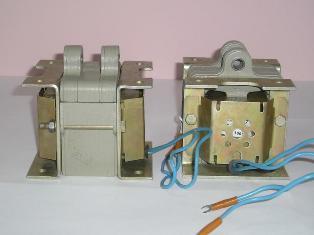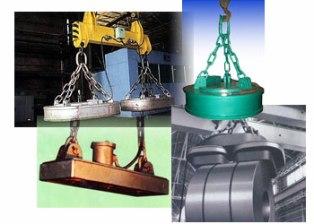Electromagnets and their applications
An electromagnet creates a magnetic field using a coil streamed with electric current. To amplify this field and direct the magnetic flux along a specific path, most electromagnets have a magnetic circuit made of mild magnetic steel.

Application of electromagnets
Electromagnets have become so widespread that it is difficult to name a field of technology where they are used in one form or another. They are found in many household appliances — electric shavers, tape recorders, televisions, etc. Communication technology devices — telephony, telegraphy and radio — are unthinkable without their use.
Electromagnets are an integral part of electrical machines, many industrial automation devices, control and protection equipment for various electrical installations. A developing field of application of electromagnets is medical equipment. Finally, giant electromagnets are used to accelerate elementary particles in synchrophasotrons.
The weight of electromagnets varies from fractions of a gram to hundreds of tons, and the electrical energy consumed during their operation varies from milliwatts to tens of thousands of kilowatts.
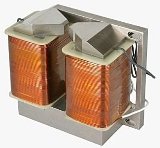 A special field of application of electromagnets is electromagnetic mechanisms. In them, electromagnets are used as a drive to perform the necessary translational movement of the working element, either to rotate it through a limited angle or to create a holding force.
A special field of application of electromagnets is electromagnetic mechanisms. In them, electromagnets are used as a drive to perform the necessary translational movement of the working element, either to rotate it through a limited angle or to create a holding force.
An example of such electromagnets are the traction electromagnets, designed to perform certain work when moving certain working bodies; electromagnetic locks; electromagnetic clutches and brakes and brake solenoids; electromagnets actuating contact devices in relays, contactors, starters, circuit breakers; lifting electromagnets, vibrating electromagnets, etc.
In a number of devices, along with electromagnets or instead of them, permanent magnets are used (for example, magnetic plates of metal cutting machines, brakes, magnetic locks, etc.).
Classification of electromagnets
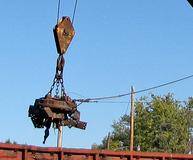 Electromagnets are very diverse in design, which differ in their characteristics and parameters, therefore the classification facilitates the study of the processes occurring during their operation.
Electromagnets are very diverse in design, which differ in their characteristics and parameters, therefore the classification facilitates the study of the processes occurring during their operation.
Depending on the method of creating a magnetic flux and the nature of the acting magnetizing force, electromagnets are divided into three groups: neutral electromagnets with direct current, polarized electromagnets with direct current and electromagnets with alternating current.
Neutral electromagnets
In neutral DC electromagnets, a working magnetic flux is created by means of a permanent coil.The action of the electromagnet depends only on the magnitude of this flux and does not depend on its direction and therefore on the direction of the current in the coil of the electromagnet. In the absence of current, the magnetic flux and the force of attraction acting on the armature are practically zero.
Polarized electromagnets
Polarized DC electromagnets are characterized by the presence of two independent magnetic fluxes: (polarizing and working. The polarizing magnetic flux in most cases is created with the help of permanent magnets. Sometimes electromagnets are used for this purpose. The working flux occurs under the action of the magnetizing force of the working or the control coil. If there is no current in them, the attractive force created by the polarizing magnetic flux acts on the armature. The action of a polarized electromagnet depends on both the magnitude and the direction of the working flux, that is, the direction of the current in the working coil.
AC electromagnets
In alternating current electromagnets, the coil is energized by an alternating current source. The magnetic flux created by the coil through which the alternating current passes periodically changes in magnitude and direction (alternating magnetic flux), as a result of which the electromagnetic force of attraction pulses from zero to a maximum with a frequency twice the frequency of the supply current.
However, for traction electromagnets, reducing the electromagnetic force below a certain level is unacceptable, as this leads to armature vibrations, and in some cases to direct disruption of normal operation.Therefore, in traction electromagnets operating with an alternating magnetic flux, it is necessary to resort to measures to reduce the depth of the force ripple (for example, to use a shielding coil covering part of the electromagnet pole).
In addition to the listed varieties, current-correction electromagnets are currently widespread, which can be attributed to alternating current electromagnets in terms of power and are close to direct current electromagnets in terms of their characteristics. Because there are still some specific features of their work.
Depending on the way the winding is turned on, a distinction is made between electromagnets with series and parallel windings.
Series windings operating at a given current are made with a small number of turns on a large section. The current passing through such a coil practically does not depend on its parameters, but is determined by the characteristics of the consumers connected in series with the coil.
Parallel windings operating at a given voltage have, as a rule, a very large number of turns and are made of wire with a small cross-section.
By the nature of the coil, electromagnets are divided into those operating in long, periodic and short-term modes.
In terms of speed of action, electromagnets can be of normal speed of action, fast-acting and slow-acting. This division is somewhat arbitrary and mainly indicates whether special measures have been taken to achieve the required speed of action.
All the above characteristics leave their mark on the design characteristics of electromagnets.
Electromagnetic device
At the same time, with all the variety of electromagnets encountered in practice, they consist of the main parts with the same purpose. They include a coil with a magnetizing coil located on it (there can be several coils and several coils), a fixed part of a magnetic circuit made of ferromagnetic material (yoke and core) and a movable part of a magnetic circuit (armature). In some cases, the stationary part of the magnetic circuit consists of several parts (base, housing, flanges, etc.). a)
The armature is separated from the rest of the magnetic circuit by air gaps and is part of the electromagnet, which, perceiving the electromagnetic force, transfers it to the corresponding parts of the actuated mechanism.
The number and shape of the air gaps separating the moving part of the magnetic circuit from the stationary one depend on the design of the electromagnet. The air gaps where a useful force occurs are called workers; air gaps where there is no force in the direction of the anchor's possible motion are parasitic.
The surfaces of the moving or stationary part of the magnetic circuit that limit the working air gap are called poles.
Depending on the location of the armature relative to the rest of the electromagnet, a distinction is made between external attractive armature electromagnets, retractable armature electromagnets and external transversely moving armature electromagnets.
A characteristic feature of electromagnets with an external attractive armature is the external location of the armature relative to the coil. This is mainly affected by the work flow passing from the armature to the end side of the core.The movement of the armature can be rotational (for example, a valve solenoid) or translational. Leakage currents (closing in addition to the working gap) in such electromagnets practically do not create traction forces, and therefore they tend to be reduced. Electromagnets of this group can develop quite a large force, but are usually used with relatively small armature strokes.
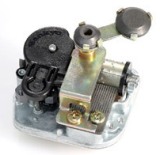 A distinctive feature of retractable armature electromagnets is the partial placement of the armature in its initial position inside the coil and its further movement in the coil during operation. The leakage fluxes from such electromagnets, especially with large air gaps, create a certain pulling force, as a result of which they are useful, especially for relatively large armature strokes. Such electromagnets can be made with or without a stop, and the shape of the surfaces forming the working gap can be different depending on what traction characteristic is to be obtained.
A distinctive feature of retractable armature electromagnets is the partial placement of the armature in its initial position inside the coil and its further movement in the coil during operation. The leakage fluxes from such electromagnets, especially with large air gaps, create a certain pulling force, as a result of which they are useful, especially for relatively large armature strokes. Such electromagnets can be made with or without a stop, and the shape of the surfaces forming the working gap can be different depending on what traction characteristic is to be obtained.
The most common are electromagnets with flat and truncated conical poles, as well as electromagnets without a limiter. As a guide for the armature, a tube of non-magnetic material is most often used, which creates a parasitic gap between the armature and the upper, stationary part of the magnetic circuit.
Retractable armature solenoids can develop forces and have armature strokes varying over a very wide range, making them widely used.
V electromagnets with an external transversely moving armature armature moves through the magnetic lines of force, rotating through a certain limited angle.Such electromagnets usually develop relatively small forces, but allow, by appropriate matching of the pole and armature shapes, to obtain changes in the traction characteristic and a high coefficient of return.
In each of the three listed groups of electromagnets, in turn, there are a number of design varieties related both to the nature of the current flowing through the coil and to the need to ensure the specified characteristics and parameters of the electromagnets.
Read also: About the magnetic field, solenoids and electromagnets

